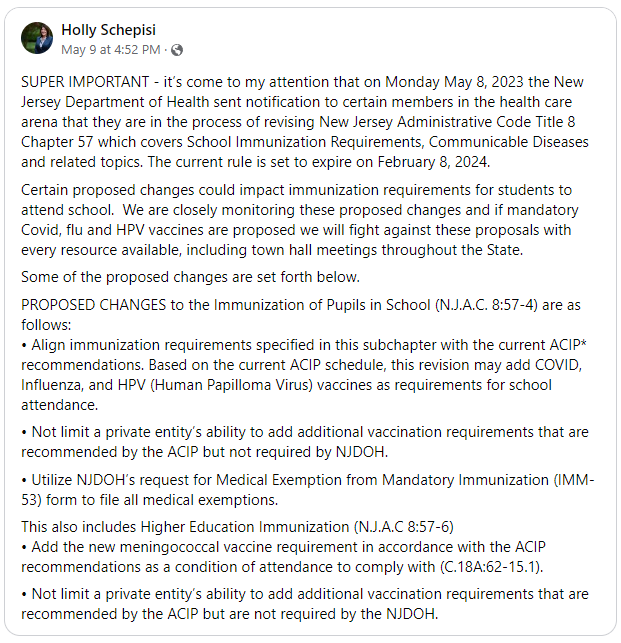COVID19, HPV and FLU may be REQUIRED For School Attendance
Please Submit your concerns to the NJDOH
Covid 19 was all based on a lie straight from the beginning. The biggest lie was how it killed and hospitalized children. School age kids were masked for 2 years and forced into inconvenient policies in the hopes that parents would be coerced into vaccinating their children.
The panic to mask and rush to vaccinate healthy children is not supported by the data collected from the NJ death certificate database (NJ SHAD).
Since the beginning of this pandemic, children STILL have a NEAR ZERO risk of death or long term side effects from COVID 19. The American Medical Association states that at least 75% of the children who acquired COVID-19 showed NO SYMPTOMS at all.
Pfizer is still testing their BioNTech vaccine on children in world wide clinical trials. There is no proof that there is a benefit to children since the original clinical trial was only performed on adults. The benefit to adults is not that striking either. There is no risk assessment weighting the benefit of the vaccine compared to the reported side effects. Two serious conditions (myocarditis and pericarditis) after mRNA COVID-19 vaccination are still being studied according to the CDC. These heart indications are rare, but it’s also rare for children and young adults to die or have long term effects from actual disease itself. Pfizer has yet to prove that this product’s benefits outweigh the risks in children.
Even Dr. Joseph Ladapo, the state surgeon general of Florida does NOT recommend COVID-19 vaccination for healthy children (ages 5-17) as stated on the Florida Health department website.
There are other factors to consider, COVID19 has had time to mutate to the point that the original vaccine may not be as effective towards new variants. Effectiveness after one dose of the Pfizer vaccine was notably lower among persons with the Delta variant than among those with the Alpha variant. A study straight from the CDC shows that the vaccine effectiveness for Omicron variant was lowered to 53.9% in kids 12-15 years old.
In my opinion, depleting effectiveness from a vaccine that prevents a disease to which healthy children are symptomless is certainly not worth the slight risk of having a serious adverse effect (complication) from the vaccine.
It was disturbing to see this warning by Senator Schepisi.
It’s also disturbing that NJDOH would require the HPV vaccine as a condition to go to school, considering that it is a sexually transmitted disease. The purpose of the school required vaccines is to prevent communicable disease from spreading. Children shouldn’t be having sex in school, and if they are, then it’s not a safe place for children.
We need to get ahead of this before they make any permanent decision.
The NJDOH wants to hear from all stakeholders. We need to make our voices heard. The deadline to submit your comments is May 31, 2023. Click below to fill out the NJDOH form.
Not all the proposed changes are mentioned here so we are sharing a video made by our friends at NJ PhiPac so you can stay informed.







The effectiveness percentage itself is highly misleading because it refers to the Relative Risk Reduction, which is a relatively meaningless comparison of people in a much greater number of study participants, and not the Absolute Risk Reduction., which compares the number of people benefitting from the shot against all people taking the shot, which is the gold standard. I have the Pfizer, Moderna, and J&J original study results. In optimal pre-variant circumstances, the Absolute Risk Reduction for each was BELIOW 2%. For Pfizer it actually was under 1%. This is real and provable with their own data. These things never worked. And only healthy adults participated in those studies, no children, pregnant women, or people with a variety of medical ailments.
People also should know that in 2017 the FDA was putting out guidance suggesting that ONLY Absolute Risk Refuction may be advertised by Pharma companies for purposes of truth in advertising because it is the true measure of effectiveness, comparing those benefitting against the entire universe of those receiving the shot, making is a true comparison for purposes of effectiveness. If the current advertised effectiveness rate for children is 54%, you can safely bet that fewer than 1% are benefitting on an Absolute Risk Reduction basis. In other words, it is grossly misleading and is absolutely not worth the risk.
I too provided comments. Thank you, for all that you do, tirelessly, to keep us informed.